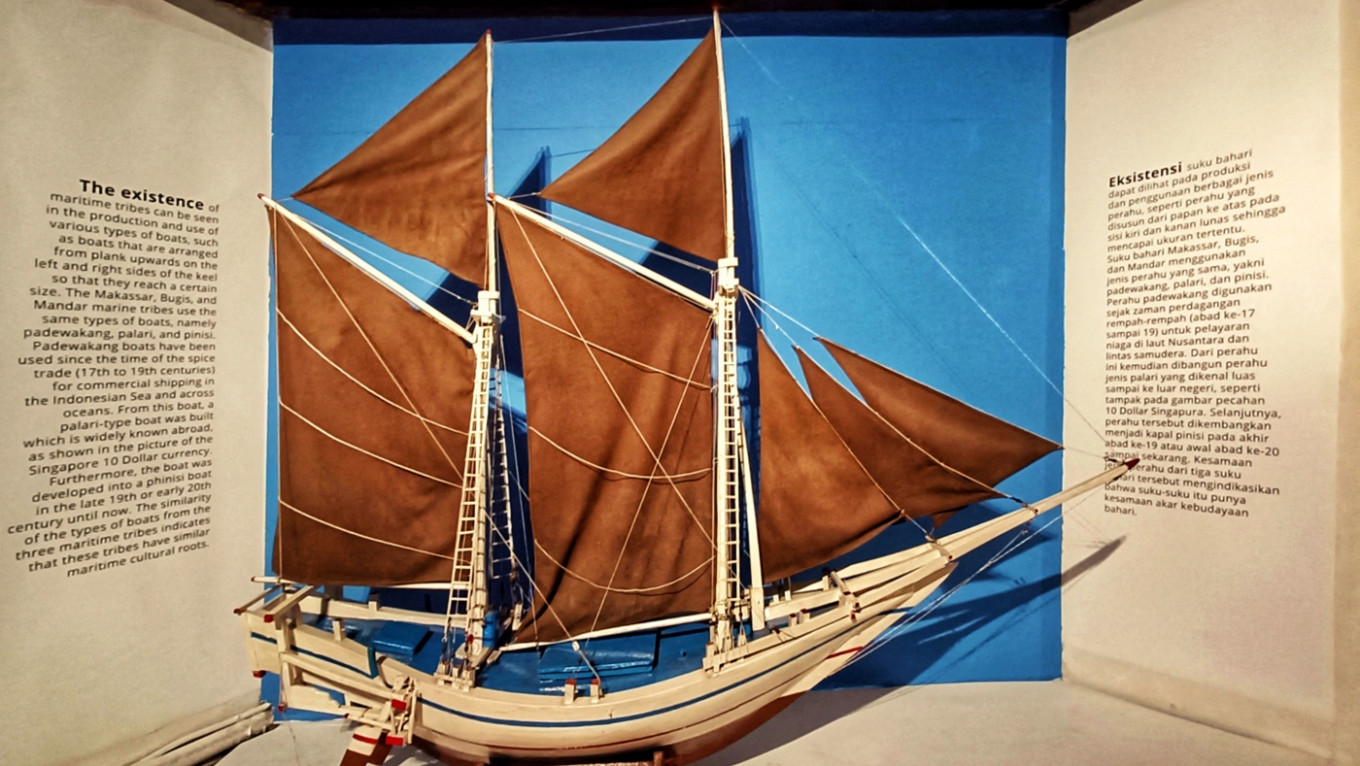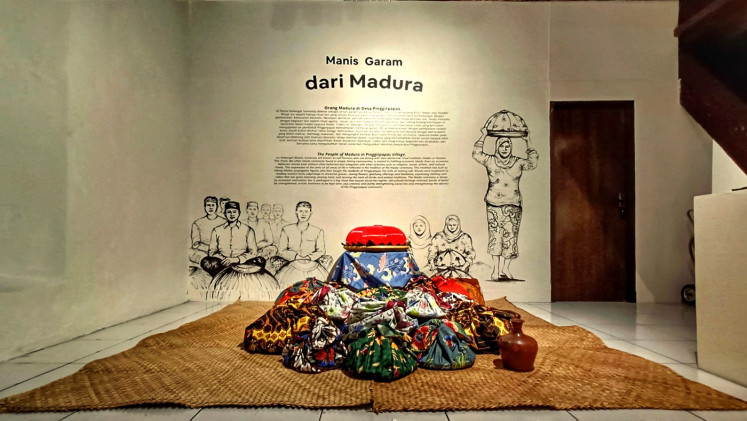Popular Reads
Top Results
Can't find what you're looking for?
View all search resultsPopular Reads
Top Results
Can't find what you're looking for?
View all search resultsThe Jakarta Maritime Museum highlights the struggles of Indonesian seafaring tribes
The Art.The.Fact! Suku Bangsa Bahari Nusantara exhibition features many aspects of the maritime people of South Sulawesi and Madura.
Change text size
Gift Premium Articles
to Anyone
T
he Art.The.Fact! Suku Bangsa Bahari Nusantara exhibition features many aspects of the maritime people of South Sulawesi and Madura.
The song “Nenek Moyangku” (“Our Ancestors,” Ibu Soed, 1940) echoes throughout the halls of the Jakarta Maritime Museum on Dec. 2. For many, the music brings back memories of our school years, where we learned about our ancestors; seafaring people who built many sturdy ships that navigated them through storms and explored deep oceans of faraway continents.
Yet, in this modern era, few young Indonesian urban people can relate to the life and struggles of the seafaring tribes. Their stories have become legendary tales with vague details.
Now, we can truly delve into the life of the seafaring people of Indonesia at Museum Kebaharian Jakarta (Jakarta Maritime Museum) in North Jakarta. From Dec. 2, 2022, to Mar. 2, 2023, the museum hosts an exhibition themed Art.The.Fact! Suku Bangsa Bahari Nusantara (Art.The.Fact! The Archipelago's Seafaring Tribes) in its temporary exhibition hall.
"Indonesia is blessed with more sea than land," Mis'ari, head of the Jakarta Maritime Museum, said at the opening of the exhibition on Dec. 2.
"Our seafaring tribes have impressed people from many different countries with their ship-making technology, immense knowledge, expertise and rich cultural traditions. The young Indonesian urban people should learn about them and their great contributions to the country."
Indonesia has over 3.2 million square kilometers of sea; about 62 percent of the archipelago's total area. Approximately 1,300 of our indigenous tribes are seafaring people. Their know-how, laws and cultural traditions have contributed to our current existence.
Traditional sea transportation
The exhibition, which is open from Tuesday to Sunday from 8 a.m. to 4 p.m., features some of the ships, fishing gear, cuisines and cultural rites of the seafaring people of South Sulawesi and Madura.
Four Indonesian scholars curated the exhibition, including an archeologist, a museologist, a sociologist and an independent researcher.
"We wanted to feature more [Indonesian seafaring tribes]," archeologist Supratikno Rahardjo, one of the exhibition curators, said. "But we don't have enough space to do so. Nevertheless, we hope that today's young urban people will be able to learn more about our seafaring ancestors through the exhibition and emulate their spirit."
For the exhibition, the Jakarta Maritime Museum has collaborated with KamiSketsa Galnas, a group of Indonesian artists that sketch at the National Gallery on Thursdays, to visualize the life and work of these seafaring people through art.
"Our artists have researched about the seafaring tribes of South Sulawesi and Madura and created interpretative illustrations about them," Zamrud Setya Negara, a representative of KamiSketsa Galnas, said.
Twenty artwork by 12 members are currently being displayed at the exhibition.
One of the artwork is Pohon Kayu Bitti (Bitti Wood Tree, 2022), a pen-and-watercolor drawing by Ari Bintaro, which showcases a traditional ship being constructed near a Bitti tree (Vitex cofassus), a sturdy tree that is native of South Sulawesi.
"The drawing depicts the evolution of boats and ships in the archipelago, which started from the rudimentary perahu lesung [mortar boat] that was directly carved from a whole tree trunk," Supratikno said. "Later, people added cadik [outriggers] to the boat to enhance its balance."
A replica of South Sulawesi's iconic phinisi ship is next to the painting. Buginese sailors have sailed with these grand vessels to Africa, the Americas and Europe since the 14th century.
"We're highlighting the [phinisi] ship in the exhibition as the ship has been registered in UNESCO's intangible cultural heritage since 2017," the curator said.
Just across the room is another replica of a ship wrapped in fishing nets extending to the ceilings.
"Madura is one of the largest producers of traditional water transportation in Indonesia," Supratikno explained. "In total, they produce 36 types of traditional wooden vessels. And the most legendary one is this golekan lete [boat]."
The traditional wooden boat, which is initially about 17 meters long, can carry up to 100 tonnes of fish and cargo.
Unfortunately, many fishermen and traders have abandoned these relatively slow boats in favor of the much quicker motorized ones since the early 1980s.
"With this installation, we hope to remind people of this beautiful traditional boat and encourage them to start using it again," Firman Faturohman, educator at the Jakarta Maritime Museum, said during the interview.
The exhibition also highlights the food supplies South Sulawesi sailors often brought with them during long sea journeys.
Set on a platform at the center of the exhibition hall are jepa and kasoami, dried and salted cassava cakes made by the women of Mandar and Buton, which can last up to 20 days.
"Sailors have much better supplies now, but these traditional foods are still preferred as local snacks," Supratikno said.
Legendary vessel: The exhibition features a replica of the “golekan lete“ boat wrapped in fishing nets. (JP/Sylviana Hamdani) (JP/Sylviana Hamdani)Laws and culture of the sea
The exhibition also highlights the famous Amanna Gappa, a set of written rules by Buginese sailors in 1676. These laws bound all local and international sailors traveling through or visiting South Sulawesi between the 17th and early 20th centuries.
As showcased at the exhibition’s temporary hall wall, the laws regulated the sailors' hierarchy in ships, cargo, debts and settlement of disputes during sea expeditions.
"It's an extraordinary achievement by Buginese sailors," Supratikno commented. "The laws also show that these sailors were indeed forward-looking men."
A sailor's life is generally a tough one. Therefore, almost every seafaring tribe in Indonesia has a martial art tradition.
The exhibition showcases silat balaba, a traditional martial art of Buton, South Sulawesi, in a black-and-white mural by Duki Noermala.
"[The martial art] is an expression of the seafaring people who always had to be watchful and know how to defend themselves," Duki, who is also a member of KamiSketsa Galnas, said during the interview.
The artist also painted a mural of Nadar, a thanksgiving ceremony of the people of Pinggir Papas in Madura. The mural portrays life-sized men and women gathering for the ceremony. Just in front of the mural are pots wrapped in colorful fabrics symbolizing the foods that these people usually bring to the ceremony to eat together in a potluck style.
Visitors can also listen to the songs and prayers usually recited during this ceremony from the earphones installed near the mural.
"Standing in front of [the installation] and listening to the recording makes me feel as if I were participating in the ceremony myself," Afradani, an employee of a private company in Jakarta that attended the exhibition's opening, said during the interview. "It's a very enriching experience."
Impacts of modernity
The exhibition also features a 30-minute documentary of the people of Bajo, South Sulawesi. It shows their struggles with authority due to their nomadic lifestyle.
"Modern administrations can't keep up with their [traditional] wandering way of life," Supratikno said.
The modern lifestyle has had a negative impact on the people of Bajo. As depicted in the paintings by Kana Fuddy Prakoso, many of these people consume instant noodles these days and throw the noodles’ plastic packaging directly into their permanent residence – the sea.
The artist painted Bajo stilt villages on instant noodles cardboard boxes to make her point.
"[My paintings] serve as a reminder of the impacts of modernity on one of the oldest seafaring peoples of Indonesia," Kana said.
Another community artist, Elvin, also shows the negative impacts of modernity in his painting titled Kamu Kering, Aku Glowing (You Are Dry, I Am Glowing, 2022).
The watercolor-on-paper painting portrays a woman looking out to sea. Next to her are wooden posts from which jellyfish are being hung to dry.
"It's a critique of the modern beauty industry, which harvests many of their ingredients from the sea and thus harms the environment," Zamrud Setya Negara, a representative of KamiSketsa Galnas, said.
Madura ceremony: Pictured is a mural and installation of the Nadar ceremony from Madura island by Duki Noermala. (JP/Sylviana Hamdani) (JP/Sylviana Hamdani)Better understanding
The exhibition also features traditional fishing tools such as bubu, lukah and serokan, used by many seafaring tribes in Indonesia.
On the exhibition's opening day, Sardini, a staff of the museum, sat in one of the exhibition hall's corners and demonstrated bubu-making using metal wires.
"I used to be a sailor and fisherman, too," Sardini said. "And I'm so happy to be able to participate in this exhibition as it highlights our culture and traditions as seafaring people."
"I hope today's young urban people will know and understand more about us and become inspired," he said.
The Art.The.Fact! Suku Bangsa Bahari Nusantara exhibition at the Jakarta Maritime Museum is open from Tuesday to Sunday from 8 a.m. to 4 p.m. and is showing until March 2, 2023.













